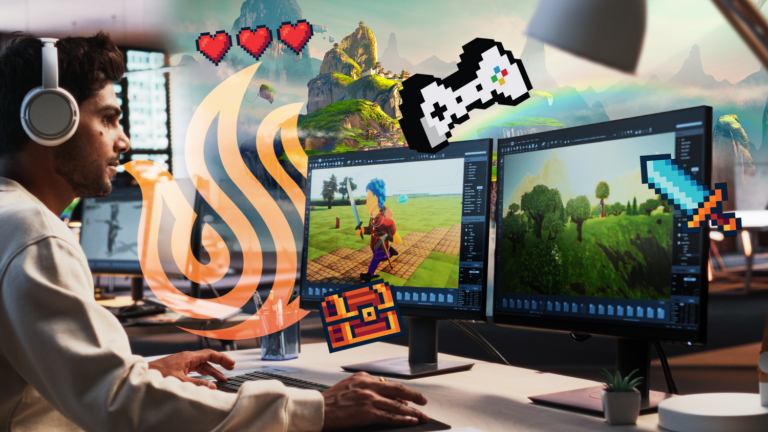
Games of the past offered interactivity primarily in the forms of buttons or joysticks, pixel visuals, and sound. Some games, such as Missile Command, introduced a roller ball. Dragon’s Tale, introduced professional, cartoon-quality graphics.
As computer games evolved, however, interactivity became more varied, allowing for more immersive experiences. For instance, role-playing games gained text-input capabilities, allowing the protagonist to talk to non-playing characters. Graphic game changers like MYST introduced gallery-quality graphics and the ability to explore a beautifully rendered island while solving riddles, following clues, and uncovering the mysteries of the island’s backstory. Some puzzles included pushing a button in one area of the island that had an effect elsewhere
Finally, other games, such as Myth, offered a groundbreaking type of interactivity–AI, requiring the player to mentally engage the game at an entirely new level of skill. For instance, in Myth the monsters would attack as monsters do, however, as the player engaged in repeated battles, they learned their tactics. This was rare in games because usually monsters simply acted with kamikaze intent, attacking headlong until either the player or they were destroyed. Monsters in Myth, however, exhibited narrow battle intelligence.
For instance, if a player traditionally shot them with bows, they would eventually stop attacking said player and gather beyond arrow range. If that player switched to swords, they would resume their attack. If the player switched back to arrows, they would retreat. At this point, in the middle of the action, the player would sit amazed at the complexity of it all while trying to take a moment and outsmart this opponent. Although the mechanics of interaction remained button pushes, those button pushes triggered new AI algorithms and an entirely new experience.
Fast forward to today, if a game is not interactive in a variety of ways, then the aspiring game developer is making the job of creating engaging games ten times more difficult than it should be.
What is Interactivity?
Game interactivity can be defined as features designed to help a player experience the story, mechanics, and environment of a game. The key to this definition is the word “experience.” Interactivity helps players to experience the game, and better experience creates deeper immersion. By adding interactivity into a game, a developer immerses the player into a fantasy world that separates in the player’s mind the real world from the game world, according to The Artifice.
Consider Halo or Rock Band, when people play these games, the real world recedes as the player becomes immersed in the game. For Halo, this level of immersion is accomplished via a game controller, phenomenal visuals, and mazes which require intellectual interaction.
For Rock Band, this immersion is accomplished via musical equipment, such as guitars and drums. In Rock Band, the mental and emotional interactivity are profound as fans of this game can attest. Basically, Rock Band taps into the rock-star in everyone and for the player the strumming of the strings and the banging of the drums sweep them away.
Designing Interactivity into Game Play
Making a game interactive requires a developer to understand two things. First, that the interaction should be centered around the game’s unique features and second, the types of interactions available to a game.
Centering Interaction Around a Game’s Primary Set of Unique Features
First, the developer needs to keep in mind the game’s primary and unique features because these features are what drive the game’s development. Ultimately, the game’s unique features are why players will play it.
For instance, if a game involves shooting from a turret, the developer might do well to include VR interactivity that involves a 360-degree dashboard, cockpit, and gun controls. However, if the game does not integrate well with VR, including a VR component into it simply because VR is the hot thing in the market can make people ultimately view the game as over-complicated and pointless.
Similarly, if the game involves being trapped in a science-fiction lab, it might make sense to include puzzles. It might also make sense to include an AI robot to help guide the player through the puzzles. As a twist, a developer might make the AI robot outwardly friendly but secretly playing the role of antagonist intent on killing the player by leading them into traps. Including puzzles and an audible AI that talks to the player and offers (deadly) advice might not make sense for many games, but for Portal, the 2007 game released by Valve, it was this type of interactivity that made it an award winner. In this game, the interactive mechanics included pushing buttons, but the player interacted with the game via audio, story, and character. Mentally, the player was always engaged, trying to figure out the puzzles and decide if the AI robot was a friend or foe.
Types of Interaction in Game Play
The following interactions are not going to be categorized as opening doors or picking up swords. These types of specific actions are innumerable. Instead, the interactions will be categorized as cerebral, emotional, or physical.
Cerebral interactions include such things as strategy. Emotional interactions include empathizing and identifying with a character. Physical interactions include pushing buttons or hearing sounds.
Additionally, the source of the interactions can be the player or the game. For instance, a player can push a button to shoot a gun. However, monsters in a game can surround the player, forcing them to strategize an escape. Additionally, haptic devices can interact with the player by simulating physical forces.
Interaction #1: Touch
Using body movement as the primary means for players to experience the mechanics of the game is what most games do. Players push buttons, or they swipe screens. Perhaps they aim a VR controller and pull a VR trigger on a VR gun. With touch, they pick up and transport objects. They open doors, push objects, or pull levers.
However, technological advancements have resulted in haptic feedback in which some type of tactile stimuli are provided by the game to convey events. For instance, controllers with rumble packs vibrate to mimic a bullet’s near miss. Actual haptic suits now exist that can give the impression of bullet impacts. Additionally, pilot seats made to scale are fitted with sensors and gimbal heads that tilt a seat with the flight of a plane or star ship. In each instance, players get an enhanced sense of immersion via all the different ways they are able to interact with the characters and objects in the game world.
Interaction #2: Audio
Bad sound design or quality kills a game. To help a player experience a game, the developer will include sound effects and music. A developer might also include non-playing characters that talk to the players. Recorded messages can convey information, prompting the player to investigate a scene. For some types of meditative experiences that take place in virtual reality, beeps might be synchronized with changes in heart rate, indicating stress. When a player hears the beep, they can actively attempt to achieve a greater sense of calm.
Interaction #3: Smell
Although rarely used in games, smell is making its way into VR experiences. For instance, meditative boutiques use VR to transport someone to a distant island. The chair in which the person sits will be surrounded by fans, intended to mimic wind. In terms of smell, aromatherapy is then used to create a greater sense of immersion. The act of inhaling becomes a way to interact with the virtual world.
Interaction #4: Sight
Modern graphics have reached the level of photo-realism. Many modern games achieve immersion via stylistic graphics. Hunters Gate, for instance, is stylized and does not attempt any sort of actual realism.
Because Hunter’s Gate is a VR experience, sight and body motion are intermingled via six degrees of freedom that allow players to peer over the edges of fences or cliffs into the depths of the fantasy abyss. This type of visual interaction can be quite fun or unsettling.
Interaction #5: Taste
Like smell, using taste to interact with games is rare. However, Edible Games offers people the chance to become “Master Food Taster of the Land.” In the game, Master Taster, people cook dishes and receive points for using a variety of ingredients to achieve high rank.
Interaction #6: Intellect and Emotion
The aforementioned Portal requires players to second guess the instructions of a privately murderous AI. In terms of emotion, The Sims is one of the most successful series in gaming history, and it involves raising simulated people with whom players become very attached. In terms of interaction, this is achieved through pre-planning (intellect), providing assistance (intellect and touch), and monitoring progress (passive watching and caring).
Additional examples of emotional interactivity include girlfriend or boyfriend apps where people can talk to an AI chatbot that is personified by an avatar. Although the graphics are typically stylistic, this type of subjective interaction based on emotional connection has found its own market across the globe. Players can talk with the avatar via audio or text to speech. They can see the character and read emotions as delivered by graphics and emojis. Finally, they can buy things for the character or stage buying and sharing a dinner with the character.
Interaction #7: Psychological Warfare
Psychological warfare is a subtle form of interaction that involves intellectual and emotional elements. Fortnite, for example, offers the following typical primary modes of interaction:
- shooting
- collecting
- building
- talking to teammates
- strategizing against other players
- attempting to forecast the storm’s shifting position
An intellectual type of interaction can include the simple act of wearing specific clothes or using various harvesting tools. For instance, a new player is provided a standard-issue paraglider to sail from the battle bus to the island below. However, some people sport an umbrella. Other people sport custom skins.
Sporting an umbrella sends the signal to others that this player has won at least one tournament. This signal of skill serves as a warning. Additionally, if a player sees an opponent with a customized skin, that opponent obviously spends a lot of time in the game and is likely skilled.
Players who sport an umbrella or wear custom skins are engaging in psychological warfare against other players in that these visual signals are used to intimidate opponents. Nervous opponents are more prone to overreact and shoot wide and frantic while players with umbrellas or custom skins might remain calm, thus increasing their chances of winning battles.
New and Evolving Interactive Elements
Eye tracking is now being used in some VR goggles. This type of interaction impacts the game based on where someone looks. With this type of interactivity, game events can be initiated or postponed by a gaze.
Choice in Game Play
Choice is an emerging element in video games. Players choosing their own adventures has been around for decades, this type of choice-based game is now a new breed of gamified movie. For instance, via a remote, Netflix allows viewers to play their way through an episode of Black Mirror. By clicking buttons and reading prompts, viewers become players able to impact the plot or the lives of the characters.
Coherence in Game Play
If interactions center around a game’s unique features, the game itself will make sense to players as the interactions serve to enhance the experience. However, interaction just for the sake of interaction can result in too many ways for a player to fiddle around in the game environment which could result in confusion, frustration, and attrition.
Conversely, a coherent, unique game that focuses only on the most essential aspects necessary for fun game play will be unlike anything else. By achieving this level of uniqueness, a developer increases their chances of success and introduces the possibility of achieving a runaway hit.
Did learning about designing interactivity into game play interest you? Today, the creative and financial success of major game releases increasingly depend on the strength of the game’s world, characters and story. University of Silicon Valley’s new Bachelor’s in Game Design Art Game Writing degree concentration—one of only a few such programs in the world—was developed to empower and support aspiring writers and narrative designers who want to be a part of this bold new storytelling frontier.
University of Silicon Valley is uniquely poised to offer a meaningful and valuable education for 21st century students. We believe in an education that directly correlates with the work you’ll be doing after you graduate. Interested in learning more? Contact Us today.


